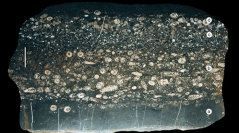

 Geodiversitas
36 (3) - Pages 349-383
Geodiversitas
36 (3) - Pages 349-383Based on the morphology of the aperture and internal plaits or folds, the Nerineoidea Zittel, 1873 are subdivided into seven families: the Pseudonerineidae Pchelintsev, 1965, Ceritellidae Wenz, 1940, Nerinellidae Pchelintsev, 1960, Eunerineidae n. fam. (new family that includes the Nerineidae Zittel, 1873 (pars) and the Diptyxidae Bouchet & Rocroi, 2005) the Ptygmatididae Pchelintsev, 1960, Nerineidae and Itieriidae Cossmann, 1896. The internal plaits of the Nerineoidea had different functions: the columellar plaits subdivided the columellar muscle into strands, which allowed portions of the foot to be moved individually. A tubelike space delimited by the parietal and palatal plaits is compared with the pallial caecum or posterior mantle chamber of heterobranchs and served the respiration. Waste from both mantle chambers was expelled through a subsutural notch, which is the common feature of the Nerineoidea. The Nerineoidea were shell draggers and probably deposit feeders with a semi- infaunal mode of life. The “Lower Heterobranchia” represented by the Streptacidoidea Knight, 1931, Nerineoidea and Acteonelloidea Akopjan, 1976 cluster outside the Euthyneura Knight, 1931. The Acteonelloidea, the second group of large Heterobranchia are related to the Nerineoidea and cannot be part of the Acteonoidea. The extinction of the Eunerineidae n. fam., the Ptygmatididae and Ceritellidae in the Late Cenomanian was caused by a general warming in low latitudes. The Acteonellidae genus Trochactaeon Meek, 1863 replaced the extinct Eunerineidae n. fam. ecologically in shallow marine soft-bottom environments and became extinct itself in the Lower Campanian due to the general cooling. In the Caribbean palaeobiological province, the endemic Nerineoidea genus Plesioptygmatis Boese, 1906 extended stratigraphically to the basal Late Maastrichtian. Acteonella d’Orbigny, 1842 and the endemic Acteonellidae genus Mexicotrochactaeon Akopjan, 1972 ranged upwards into the Late Maastrichtian.
Nerineoidea, Acteonelloidea, Heterobranchia, Gastropoda, Mesozoic, functional morphology, ecology, diets and feeding, phylogeny, extinction, new family.